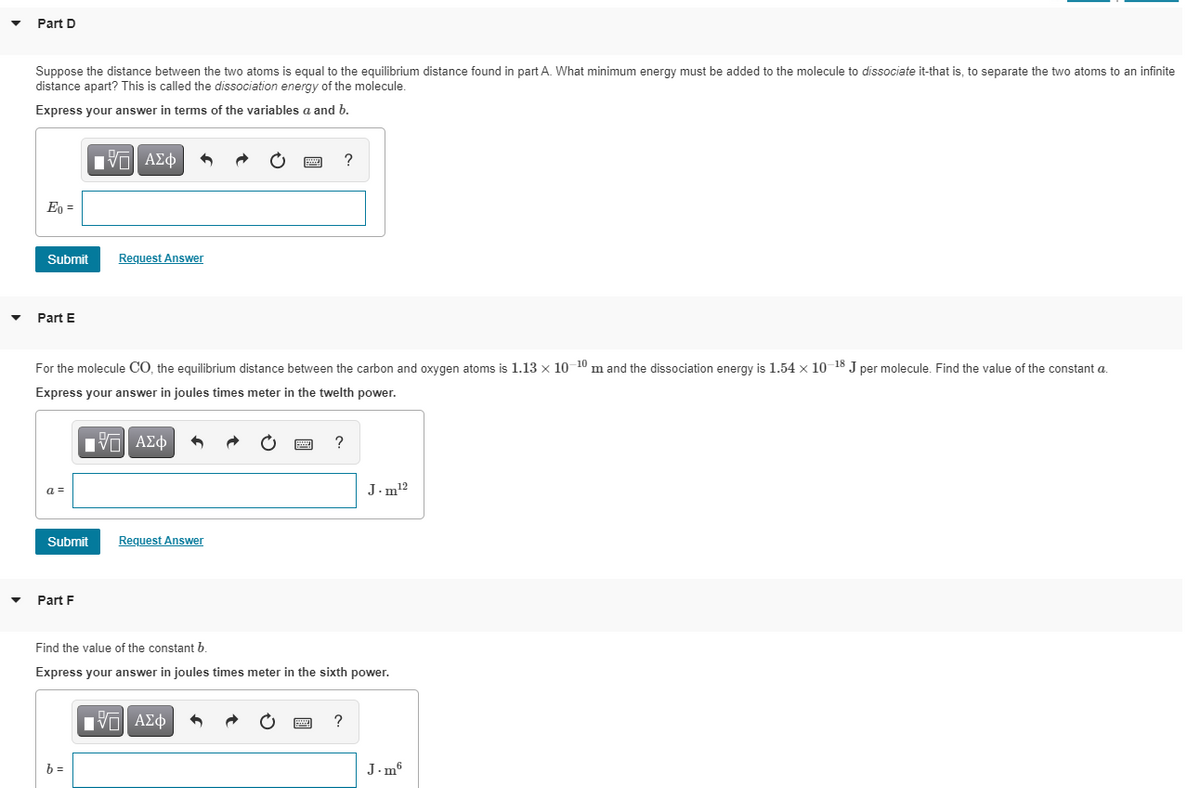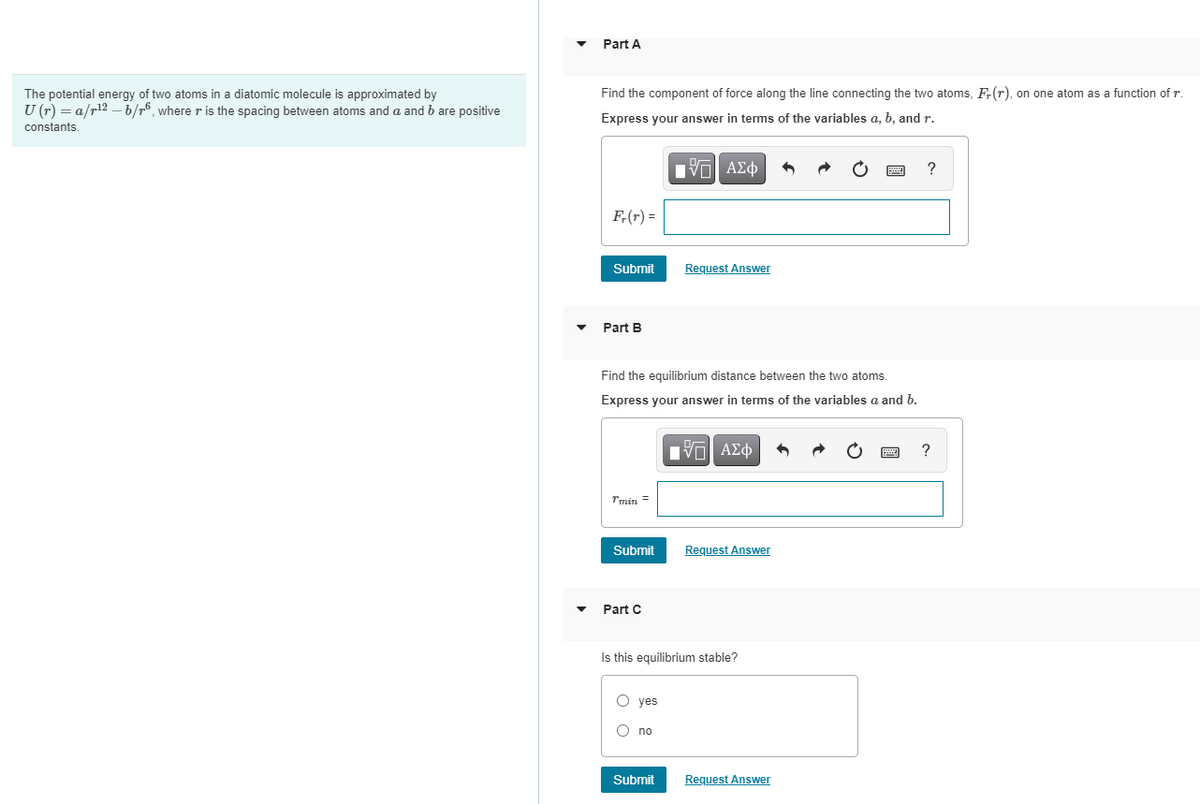Part D Suppose the distance between the two atoms is equal to the equilibrium distance found in part A. What minimum energy must be added to the molecule to dissociate it-that is, to separate the two atoms to an infinite distance apart? This is called the dissociation energy of the molecule. Express your answer in terms of the variables a and b. ? E = Submit Request Answer Part E For the molecule CO, the equilibrium distance between the carbon and oxygen atoms is 1.13 x 10-10 m and the dissociation energy is 1.54 x 10 18 J per molecule. Find the value of the constant a. Express your answer in joules times meter in the twelth power. ? a = J.m12
Part D Suppose the distance between the two atoms is equal to the equilibrium distance found in part A. What minimum energy must be added to the molecule to dissociate it-that is, to separate the two atoms to an infinite distance apart? This is called the dissociation energy of the molecule. Express your answer in terms of the variables a and b. ? E = Submit Request Answer Part E For the molecule CO, the equilibrium distance between the carbon and oxygen atoms is 1.13 x 10-10 m and the dissociation energy is 1.54 x 10 18 J per molecule. Find the value of the constant a. Express your answer in joules times meter in the twelth power. ? a = J.m12
College Physics
11th Edition
ISBN:9781305952300
Author:Raymond A. Serway, Chris Vuille
Publisher:Raymond A. Serway, Chris Vuille
Chapter1: Units, Trigonometry. And Vectors
Section: Chapter Questions
Problem 1CQ: Estimate the order of magnitude of the length, in meters, of each of the following; (a) a mouse, (b)...
Related questions
Question

Transcribed Image Text:Part D
Suppose the distance between the two atoms is equal to the equilibrium distance found in part A. What minimum energy must be added to the molecule to dissociate it-that is, to separate the two atoms to an infinite
distance apart? This is called the dissociation energy of the molecule.
Express your answer in terms of the variables a and b.
Πνα ΑΣφ
?
En =
Submit
Request Answer
Part E
For the molecule CO, the equilibrium distance between the carbon and oxygen atoms is 1.13 x 10 10 m and the dissociation energy is 1.54 x 10 18 J per molecule. Find the value of the constant a.
Express your answer in joules times meter in the twelth power.
a =
J.m12
Submit
Request Answer
Part F
Find the value of the constant b.
Express your answer in joules times meter in the sixth power.
Πνα ΑΣφ
?
b =
J.m6

Transcribed Image Text:Part A
Find the component of force along the line connecting the two atoms, F;(r), on one atom as a function of r.
The potential energy of two atoms in a diatomic molecule is approximated by
U (r) = a/r12 –b/r°, where r is the spacing between atoms and a and b are positive
Express your answer in terms of the variables a, b, and r.
constants,
F,(r) =
Submit
Request Answer
Part B
Find the equilibrium distance between the two atoms.
Express your answer in terms of the variables a and b.
Eνα ΑΣφ
?
Tmin =
Submit
Request Answer
Part C
Is this equilibrium stable?
O yes
O no
Submit
Request Answer
Expert Solution
This question has been solved!
Explore an expertly crafted, step-by-step solution for a thorough understanding of key concepts.
This is a popular solution!
Trending now
This is a popular solution!
Step by step
Solved in 4 steps with 4 images

Knowledge Booster
Learn more about
Need a deep-dive on the concept behind this application? Look no further. Learn more about this topic, physics and related others by exploring similar questions and additional content below.Recommended textbooks for you

College Physics
Physics
ISBN:
9781305952300
Author:
Raymond A. Serway, Chris Vuille
Publisher:
Cengage Learning

University Physics (14th Edition)
Physics
ISBN:
9780133969290
Author:
Hugh D. Young, Roger A. Freedman
Publisher:
PEARSON

Introduction To Quantum Mechanics
Physics
ISBN:
9781107189638
Author:
Griffiths, David J., Schroeter, Darrell F.
Publisher:
Cambridge University Press

College Physics
Physics
ISBN:
9781305952300
Author:
Raymond A. Serway, Chris Vuille
Publisher:
Cengage Learning

University Physics (14th Edition)
Physics
ISBN:
9780133969290
Author:
Hugh D. Young, Roger A. Freedman
Publisher:
PEARSON

Introduction To Quantum Mechanics
Physics
ISBN:
9781107189638
Author:
Griffiths, David J., Schroeter, Darrell F.
Publisher:
Cambridge University Press

Physics for Scientists and Engineers
Physics
ISBN:
9781337553278
Author:
Raymond A. Serway, John W. Jewett
Publisher:
Cengage Learning

Lecture- Tutorials for Introductory Astronomy
Physics
ISBN:
9780321820464
Author:
Edward E. Prather, Tim P. Slater, Jeff P. Adams, Gina Brissenden
Publisher:
Addison-Wesley

College Physics: A Strategic Approach (4th Editio…
Physics
ISBN:
9780134609034
Author:
Randall D. Knight (Professor Emeritus), Brian Jones, Stuart Field
Publisher:
PEARSON